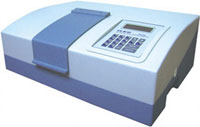Laboratory Equipments >> Spectrophotometers >> Bio Spectrophotometer
|
| |
|
|
Specification for Bio Spectrophotometer
Spectral
| Range |
190 to 1100nm |
| Bandwidth |
1.8 nm |
Photometric
| System |
Double beam optics |
| Range |
± 3.000 Abs |
| Stability (baseline) |
0.003 Abs/hr. after 2 hour warm up |
| Stray light |
<0.5% T at 220 nm with Nal 10g/l |
| Light Source |
Deuterium lamp (d2) & tungsten (W) halogen lamp |
| Monochromator |
Concave holographic grating with 1200 lines/mm |
| Control |
Microprocessor and microcontroller (computer – optional) |
Data Processing
| Microprocessor mode |
Spectrum, Concentration, Protein Assay DNA I RNA purity, Concentration by Factor, Enzyme Kinetics |
| PC mode |
Spectrum, Overlay, Time Scan, Enzyme Kinetics, Multiwavelength, Ratiometric, Quantitative, Peak picking Spectra zooming, Smoothening, Averaging, Comparison, Data saving & Retrieving, up to 4th order Derivative and printing |
Sample Attachment
| Standard |
Fixed 10mm path holders for reference & sample |
| optional |
Fixed cell holder to accommodate microcuvettes |
| Pc Connectivity |
USB interface |
|
Features and Benefits of Bio Spectrophotometers
- Smallest form factor double beam spectrophotometer with a high-resolution bandwidth
- Comes with automatic wavelength calibration and programmable wavelength for lamp change over
- Lamp selection enables conserving the life of the wo lamps, deuterium and tungsten with auto focusing
- Menu driven microprocessor based software makes the stand-alone unit user friendly.
- Stand alone unit offers an advanced technology with data processing features for scanning discrete wavelength, concentration determination by standards and E-factor method, time scan with minimum time interval of 1.0 sec, auto-zero facility, self check and self diagnostic modes.
- Software is 21 CFR Part 11 compliant with password method protection, Instrument logbook etc. cGLP compliance addressed.
Applications for Bio Spectrophotometers
- For any spectrophotometric or colorimetric measurement where applications require very high-resolution bandwidth and cGLP compliance is mandatory.
- DNA/RNA Quantification
- Nucleic Acid Purity by Absorbance ratio and concentration by factor method
-By UV Absorbance, Lowry, Biuret, CBB and BCA methods
- Enzyme kinetics
- Micronutrients like N, P, K, S, Ca, Mg, Zn, Cu, B, Mo, etc., in Agricultural soil, Plants etc.
- Organic compounds in biological matter
- Glucose ,fructose ,carbohydrates ,protein etc., in foods.
- Edible dyes, alcohols etc., in beverages
- Purity of constituents in pharmaceuticals
- Toxic elements like cadmium, lead, mercury, arsenic and mercury etc., in effluents.
- Constituents in compositions used in metallurgy, fertilizer, pesticide, chemical, petrochemical, steel, cement, glass & other industries.


